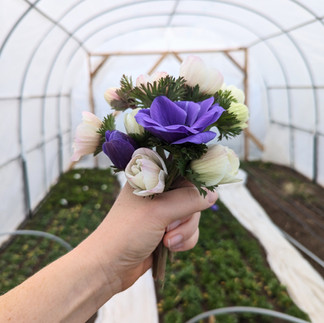- farm47nm
- Mar 19, 2024
- 3 min read
Part 2 - How they all bloomed
It's been almost three whole months since I planted the first batch of indoor tulips. Now that the last flower has been cut, I'm here to say it was the most fun I've ever had during the winter months!
Is it just me, or are tulips not the most photogenic flower? I am still under their spell and am dying to show them off. I'm just the proudest plant parent ever! Without further ado, here is a photo journey of delightful tulips to feast your eyes upon...

Fringed variety 'Louvre'. My favorite of the purple and white color set!
This year I curated three different color palettes for my bouquet subscription. I ordered five varieties per color set with the intention of creating a dynamic mix even if a few of the varieties weren't up to par. I'd say this strategy worked out nicely. As always, several expected and unexpected things happened: substitutions and shortages from the bulb supplier, varieties that were too short to work in a bouquet, disease and misaligned timing.

Valentine's Day colors that didn't actually bloom for V-day.
Luckily, this was a trial year so none of these issues were insurmountable, just irritating. I say it every year and it remains true: fulfilling bouquet subscriptions is the most anxiety inducing part of the job. This wasn't quite as bad as forecasting blooms grown outside, but it takes time and experience to understand the nuance of how fast buds turn to blooms. Some varieties are ready in a few days after they start budding and others take longer. Add warmer temperatures and that throws everything off.
Yes, there was indeed an unintentional pink in the purple/white set.
Fun fact: tulips can hang out in my flower cooler for a short time with their bulb still attached with the right humidity and temperature settings. Oh, but only if they are picked a the right stage. And only if they feel like cooperating, or so it seems. Have I mentioned that tulips are divas?

Demanding blooms but well worth it.
Just in case you were curious, here's my post-harvest process:
Harvest 2x per day (in the comfort of my warm house!), wrap stems in kraft paper and place in the cooler.
The night before bouquet delivery: snip off the bulb, remove bottom leaf and hydrate over night.
Day of delivery: carefully assemble the most perfect blooms, delicately wrap and lovingly hand-tie each bouquet
Photograph, photograph, photograph
Deliver the most amazing tulips to the good people of Albuquerque!
The process in five photos. Don't let this simplicity fool you, it's harder than it looks.
Overall, this winter was glorious! January through March brought wave after wave of color and inspiration. I feel like all the planning that went into the different palettes was worth it because they were all beautifully unique. Like any good plant parent, I can't pick favorites but I will share some highlights.
'Columbus' just beginning to color up to fully open.
'Columbus'
This double tulip was incredible! I'm not sure if she is my favorite purely because of her beauty or because she is the first double tulip I've grown that had longer than a 3" stem. I have never been a pink-lovin' kinda gal, but watching all the different colors shift and change during the week was nothing short of magical.
'Jochem', 'Charade' and 'Cadans' - which is which? Who knows!
'Cadans'
Maybe? I ordered three orange varieties which all had blends of orange, pink and yellow hues. Perhaps this is flower farmer blasphemy, but they were all so similar that I was never able to tell them apart.
'Lydia' - awkward teenager to mature sophistication.
'Lydia'
Surprisingly another another pink. I made the rookie mistake of judging this flower before letting her bloom. I was afraid that this variety was going to go bad too fast because the petals were curling before they opened. Alas, she was lovely! 'Lydia' started as a semi-hot pink and soften to a baby pink with the most adorable bright tips. Not the most stand out flower, but a solid addition to many palettes.

Mix of 'Columbus', 'Lydia', 'Tom Pouce' and 'Gabrielle' in the afternoon sunlight.
Well, that's it for my winter tulip show-and-tell! Fear not, my flower friends. While the inside tulips all done, the outdoor flowers are just getting warmed up - quite literally. The spring darlings including anemones, narcissus and ranunculus are starting to bloom which means that the fall planted tulips will be flowering in just one short month. Is it ever possible to have too many tulips? I think not!































































